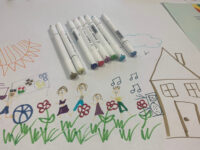
Person-centered planning is a process of exploration, inquiry, listening, and reflective practice designed to make the unknown known through words, colors, and images.
People of all ages and abilities can actively participate in their own planning process by contributing to images that represent desired outcomes and action steps toward community inclusion and valued social roles.
Graphics engage multiple senses, making it easier to remember details of a conversation. When facilitating person-centered plans these five practices will make the use of graphics more meaningful.
Invite the person to choose the colors. What is the person’s favorite color? What colors do they not like? If using marker and paper, choose a handful of colors that will work well together. If working electronically you can create a custom color palette to personalize your graphic in PowerPoint or Word. Click here to learn how to create custom themes in Microsoft applications.
Use visual questions that invite clues about what is important to the person. Ask participants to describe the images that come to mind as they share an idea or concept, whether you are working in person or remotely using technology. Kurt shared that he wanted to live in his own place, so I invited him to describe it to me. “What does it look like?” “What color is it?” “How many rooms do you see?” “What do you see on the walls in your dream home?” Draw images to represent their responses.
Ask if there is a central image that can represent the person’s planning process and goals. A team of Person-Centered Thinking trainers from central California created a 3-year PATH to embed person centered practices in their community. They described a central image of a waterfall with radiating ripples in the pool below to represent their role and mission to educate and influence. This central image provides focus and connection to shared vision, goals and commitments that were agreed on that day. It helps people to remember the conversation and connects them to the imagery in a meaningful way.
Invite participants to draw with you. They will remember images they created themselves far better than those drawn by others. Help them own the contents of the plan by contributing to the drawings. Julian joined the graphic facilitator to draw some of his own images into his Liberty Plan. He drew his own self portrait as well as his depiction of his aspiration to become a manager.
Welcome photographs, symbols, and electronic images. Anna does not use words to communicate and a member of her circle of support accompanied her throughout her day to take pictures of her favorite things, people, and activities. Together they created a deck of photo cards that Anna uses during her planning meetings and at other times to let people know what matters to her and how and with whom she wants to spend her time.
The use of graphics is most powerful when the images are defined by the person with whom you are planning. The graphic recorder captures the images as described by the person and the circle of support as a gift of perspective taking and sense making. H S A USA provides support for graphic recording as well as facilitation of PATH, Maps, Liberty Plans, Picture of a Life, and other methods of person-centered planning. We would be happy to chat with you to decide what approach will best meet your needs.
There was a problem reporting this post.
Please confirm you want to block this member.
You will no longer be able to:
Please note: This action will also remove this member from your connections and send a report to the site admin. Please allow a few minutes for this process to complete.